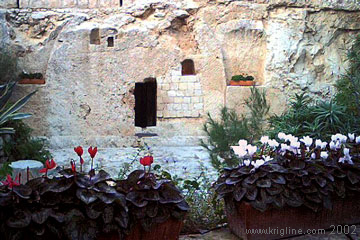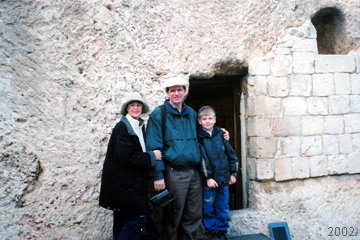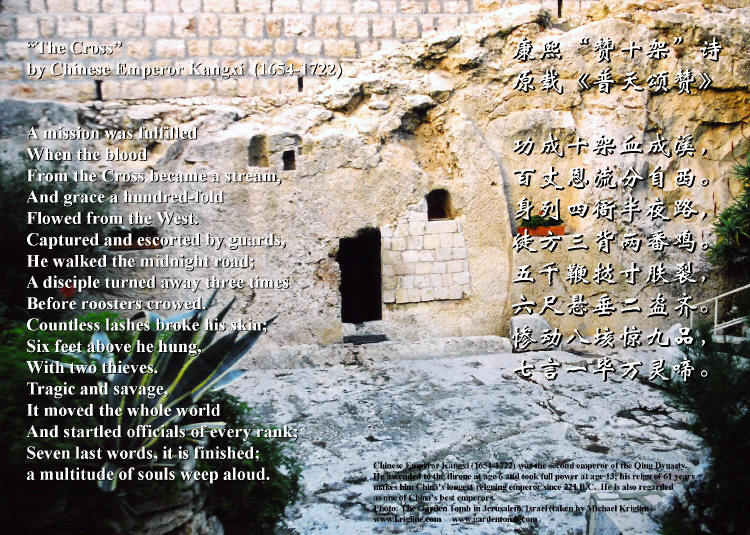(Note: This was written during my visit to the US in 2004. The
hot movie during that visit was Mel Gibson's The Passion of the
Christ, rated R for showing excessive violence and torture. It
became the seventh biggest US box-office hit in movie history, and broke
many other records worldwide.)
The Passion of Christ
(Some of my thoughts & a remarkable
Chinese poem)
By Michael Krigline,
March 2004
Note: The word “passion” came to English (12th century) via
French from the Latin stem passion, meaning “suffering,
affection,” which came from pati “to suffer.” When capitalized,
“the Passion” refers to the sufferings of Jesus Christ from his last
supper through his death on a cross. (from Microsoft® Encarta®
Reference Library 2004)
Mel Gibson’s movie, The Passion of the
Christ, has stirred up a lot of controversy here in the States. Some say
that it is the most controversial movie of the new century, even though it
has also been one of the biggest box office successes in movie history. So
far, it has earned over $300 million, and we are still a few weeks from the
Easter season it so graphically presents on the screen. This is especially
amazing since no Hollywood studios were willing to undertake the project,
leaving Mel Gibson to provide funding and produce it himself.
A lot of the debate comes from those who
wonder if it is wise to so accurately portray the events written of in the
Bible–an accuracy that even extended to recording the scenes in the
language of the first century AD. Some believe the movie is anti-Jewish,
since it shows how the Jewish leaders put Jesus to trial and then called so
strongly for his execution. Others voice concerns over the graphic depiction
of the crucifixion, saying that there is something wrong with anyone who
would choose to watch humans giving an indescribable beating and whipping to
a man before driving nails through his hands and feet.
Perhaps it is the “indescribable” nature of
Jesus’ punishment that made Gibson feel that a visual presentation was
necessary. I have given a fair amount of time to studying the Bible
and the historical context in which the book was written. The Roman
punishment of crucifixion was one of the worst examples of man’s inhumanity
to man. Those who wrote the scriptures had all seen crucifixions in person,
and thus felt no need to describe it’s horrors in detail. But historians and
scholars say that Jesus likely went through everything shown in Gibson’s
movie, and believe it or not, it may have been even worse! Words fail in
describing such cruelty, but Hollywood magic makes the brutality believably
real.
This is important because (if the Bible
and Christians are correct), whether or not we believe what happened on that
cross is the main determiner of whether or not we will live in Heaven after
we die. As Jesus says in the movie, “No one takes my life away from me, but
I lay it down. I have the power to give it up, and the power to receive it
back again” (John 10:18, Bible). The movie also told us that the
biggest part of his pain was caused by the weight of the world’s sin—Jesus
voluntarily took this crushing burden on himself, so that when he died (in
fulfillment of prophecy), mankind’s sin would be “paid for.” This is the
meaning of the Aramaic expression Jesus uttered just before he died: “paid
in full.” Another scripture came to my mind as I watched a crude leather
whip cut stripes into Jesus’ flesh: “He was wounded and crushed because of
our sins; by his stripes we are healed. All of us were like sheep that had
wandered off. We had each gone our own way, but the
Lord gave him the punishment we
deserved.” (Isaiah 53:5-6, written prophetically 700 years before the time
of Christ.)
If I have a complaint about the movie, it
is about how it ended. Jesus died on a Friday afternoon, and movie goers are
not told that he remained sealed in the tomb until the third day afterward
(this is the day we call Easter or Resurrection Day). While I am glad it
showed Jesus alive again, I think a closing scene showing his reunion with
his followers would have provided a taste of the joy that Christians
experience when we consider the events of Easter. The resurrection was not
just about coming back to life, but about proving that the sacrifice had
worked—for the first time since Adam sinned, the way was clear for humans to
walk with God as holy (i.e., forgiven) people. Just as the earthquake shown
in the movie removed the barrier between God’s “most holy place” and “the
people,” the resurrection removed the barrier of sin between God and
humankind, for Jesus’ love had covered over the multitude of our sins. After
watching in breathless horror for two hours, it would have been nice to
leave the theater with “He is risen!” ringing in my ears.
For all its strengths and weaknesses,
The Passion does give us an accurate picture of what it cost God to pay
for our forgiveness. The cross and resurrection are the center of
Christianity and the Christian understanding of life. According to the
Bible, “Unless Christ was raised to life, your faith is useless, and you are
still living in your sins. Furthermore, those people who died after putting
their faith in him are completely lost. If our hope in Christ is good only
for this life, we are worse off than anyone else.” (St. Paul, 1 Cor
15:17-19)
Two thousand years ago, the birth of Jesus
split human history between BC and AD, and ever since then his Passion has
split humans into two opposing groups: one which embraces the resurrection
as the well-spring of faith, hope and eternal life, and one which fiercely
rejects Jesus as a mad man who has deceived millions. From the moment of
Judas’ betrayal until today, the Passion of Christ has captured the
imagination and admiration of artists and poets, even as it has prompted the
wrath of political and religious leaders all over the earth. Is it any
wonder, then, that Gibson’s movie has stirred such controversy?
Let me close by sharing the translation of
a remarkable poem, written some 300 years ago by a Qing Dynasty Emperor. In
reading these words, one can’t help but wonder if this gifted leader had
figured out the answer to the question Governor Pilate asked Jesus centuries
before: “What is the Truth?”
“The Cross” by Chinese Emperor Kangxi
康熙“赞十架”诗 (原载《普天颂赞》)
功成十架血成溪,百丈恩流分自西。
身列四衙半夜路,徒方三背两番鸡。
五千鞭挞寸肤裂,六尺悬垂二盗齐。
惨动八垓惊九品,七言一毕万灵啼。
--my translation (with the help of Kei Li):
A mission was fulfilled when the blood
from the Cross became a stream,
And grace a hundred-fold flowed from the West.
Captured and escorted by guards, he walked the midnight road;
A disciple turned away three times before roosters crowed.
Countless lashes broke his skin;
Six feet above he hung, with two thieves.
Tragic and savage, it moved the whole world and startled officials of every
rank;
Seven last words, it is finished; a multitude of souls weep aloud.
Notes: Chinese Emperor Kangxi (1654-1722)
was the second emperor of the Qing
Dynasty. He ascended to the throne at age 6 and took full power at age 13;
his reign of 61 years makes him China's longest-reigning emperor since 221
B.C. I've also heard that he is regarded as one of China's best emperors. Chinese poetry is very difficult to translate,
and this type in particular must abide by strict rules that limit the number
of characters, thus it uses
abbreviated terms and densely packed ideas. Notice how much longer the
English is than the Chinese! Page 255 of Faith of Our Fathers by Chan
Kei Thong does a great job of showing how ingenious this poem really is in
its original language.
(See a picture of the "empty
tomb" below, with more on our Israel photo page.
Read some thoughts for children on Easter by
clicking here: A Bird's Eye View of Easter.
A holiday summary for students/teachers is
also available.)


